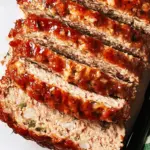The magic of these Lemonade Scones lies in their simplicity. Using just three pantry staples—self-raising flour, thickened cream, and lemonade—you can whip up fluffy, golden scones in under 30 minutes. There’s no need to cut in cold butter or chill the dough. It’s as easy as mix, cut, and bake.
These scones are an Aussie classic, reinvented for the busy home cook. Despite their name, they don’t taste like lemon; the lemonade simply adds lift and softness. Serve them warm, split in half, and slathered with jam and cream for the ultimate teatime indulgence. Whether you’re a seasoned baker or a total newbie, this foolproof recipe will have you baking like a pro.
Full Recipe:
-
3 ½ cups self-raising flour, plus extra for dusting
-
1 cup thickened cream (heavy cream), not whipped
-
1 cup lemonade (Sprite, 7UP, or similar)
-
Milk, for brushing tops
Directions:
-
Preheat oven to 200°C/390°F (180°C fan). Line a baking tray with parchment paper.
-
In a large mixing bowl, combine self-raising flour, cream, and lemonade. Mix gently until just combined—do not overmix.
-
Turn the dough out onto a floured surface. Gently knead 3–5 times to form a soft dough, then pat into a disc about 2.5 cm (1 inch) thick.
-
Use a 6 cm (2.5 inch) round cutter to cut out scones, pressing straight down (do not twist).
-
Carefully transfer scones to the prepared tray, letting them touch slightly. Brush the tops lightly with milk.
-
Bake for 15 minutes or until golden.
-
Let cool slightly on a wire rack. Drape with a tea towel to keep tops soft.
-
Serve warm with generous dollops of cream and jam.
Prep Time: 10 minutes | Cooking Time: 15 minutes | Total Time: 25 minutes
Kcal: 188 kcal per scone | Servings: 10 scones
The Simplicity and Brilliance Behind Lemonade Scones
Lemonade Scones are a testament to the magic that can happen with just a few everyday ingredients. Originating from Australia and widely cherished in homes and cafés across the country, these scones are especially renowned for how simple they are to make, yet how delightfully soft and fluffy they turn out. What makes them particularly unique is the use of lemonade—a fizzy, sweet carbonated drink—which surprisingly doesn’t lend a lemon flavor, but rather contributes to their light and tender texture. For those seeking a shortcut to traditional scones without compromising on taste or texture, this recipe is a revelation.
The name “Lemonade Scones” may cause confusion for those unfamiliar with the recipe, as it implies a citrus-heavy treat. But this couldn’t be further from the truth. In fact, the lemonade’s role is mostly functional—it provides the sweetness and the carbonation that helps aerate the dough, working in tandem with self-raising flour to ensure that the scones puff up beautifully. The result? A batch of golden-topped, pillowy scones with a slightly crisp exterior and a moist, soft crumb inside.
A Beloved Aussie Tradition
In Australia, scones are more than just a snack—they’re a cultural icon. Served with generous amounts of jam and whipped or clotted cream, they’re a staple of afternoon teas, country bakeries, church fêtes, and family get-togethers. There’s a certain nostalgic charm associated with scones in Aussie households, often reminding people of visits to grandma’s house or countryside tearooms.
Lemonade Scones are a modern twist on the traditional version, which typically involves rubbing cold butter into flour—a step that many home bakers find time-consuming or tedious. This shortcut method eliminates the need for butter entirely, and in doing so, makes the recipe not only faster but also more accessible. It’s perfect for beginners, busy parents, or anyone who wants to enjoy the comforts of fresh-baked goods without the hassle of conventional pastry-making techniques.
What Makes This Recipe So Unique
The genius behind Lemonade Scones lies in how they sidestep the complexity of traditional baking. Many baked goods require precision, time, and delicate techniques. But with this recipe, you essentially just combine three ingredients—self-raising flour, cream, and lemonade—mix briefly, shape, and bake. That’s it. The dough is intentionally sticky, which might feel unfamiliar to some, but that stickiness is key to producing a soft, moist crumb.
Unlike recipes that rely on cold butter for structure and flakiness, the combination of heavy cream and lemonade gives these scones richness and airiness. The cream provides fat and moisture, while the bubbles in the lemonade help leaven the dough. This combination ensures the scones remain tender and rise evenly without needing additional agents like eggs or extra baking powder.
Tips for Perfect Lemonade Scones Every Time
There are a few small but essential tips to keep in mind to ensure these scones come out perfect every time. First, it’s crucial not to overmix the dough. Overworking the dough can lead to dense, tough scones, which defeats the purpose of this effortlessly soft recipe. You want to stir just until the ingredients are incorporated—some visible flour is perfectly fine.
Secondly, when cutting the scones, use a sharp cutter or glass and press straight down without twisting. Twisting the cutter seals the edges of the dough, preventing it from rising properly in the oven. You should also avoid handling the sides too much, as this can also hinder the rise and lead to uneven baking.
A final tip is to place the cut scones on the baking tray so that they are just barely touching. This encourages the sides to push against each other as they rise, resulting in taller, more evenly baked scones. It’s a clever trick that speaks to the collaborative charm of baking—like little buddies helping each other grow!
Serving Suggestions and Occasions
Lemonade Scones are best enjoyed warm, ideally fresh out of the oven, or gently reheated. Traditional toppings include a thick smear of strawberry jam and a generous dollop of whipped cream. Some may prefer clotted cream for a more authentic British touch, but either works beautifully.
They pair wonderfully with a cup of English Breakfast tea or even an herbal infusion for a more contemporary twist. If you’re feeling adventurous, you can infuse the cream with a hint of vanilla or use flavored jams like raspberry, blueberry, or even passionfruit for a seasonal variation.
Perfect for brunches, baby showers, weekend tea parties, or cozy afternoons indoors, these scones offer a quick and crowd-pleasing baked treat. They also make excellent additions to picnic baskets and potluck tables.
Why This Recipe is a Game-Changer for Home Bakers
Many home bakers are intimidated by scones, thinking they require special skills or advanced techniques. This recipe shatters that myth. It opens the doors for anyone—regardless of experience level—to confidently bake a tray of scones that rivals those from a local bakery. And it does so using ingredients that are already in most pantries and fridges.
It’s also incredibly adaptable. While the standard version is sweet and best served with jam and cream, you could easily adapt the base to include savory elements like grated cheese, chives, or herbs. The dough could even be shaped into mini scones for bite-sized treats at parties or larger portions for hearty breakfasts.
For those with dietary restrictions, substitutions can also be made. Gluten-free self-raising flour blends can replace the regular flour, and plant-based creams can be experimented with, though results may vary slightly. The key is to maintain the balance of moisture and fizz to preserve the scones’ signature texture.
Common Mistakes to Avoid
Although this recipe is beginner-friendly, there are still a few pitfalls to avoid:
-
Overmixing the dough: As mentioned earlier, minimal mixing is crucial. Overmixing will activate too much gluten, resulting in a chewy rather than tender texture.
-
Using low-fat cream: The fat in the cream is essential for the richness and softness of the scones. Low-fat versions tend to produce drier results.
-
Letting the dough sit too long: Once mixed, the dough should be shaped and baked immediately to take full advantage of the carbonation in the lemonade.
-
Not flouring the cutter: Dough can stick easily, so it’s helpful to flour your cutter or knife between cuts to keep shapes clean and consistent.
The Joy of Baking Something So Simple Yet So Rewarding
In a world where food can sometimes become overly complex or reliant on niche ingredients, recipes like these remind us of the joy of simplicity. The fact that such delicious results can be achieved with only three basic ingredients and minimal effort is part of the charm. It encourages creativity, confidence, and a return to the basics of home baking.
Moreover, there’s a beautiful rhythm to making scones—mixing gently, shaping the dough, watching them puff up in the oven. It’s an act that connects generations, cultures, and memories. It’s the kind of recipe that gets passed down not just because of its convenience, but because of the warm memories it creates.
Conclusion
Lemonade Scones offer the perfect blend of ease and indulgence. With just three ingredients and no complicated steps, this recipe has become a favorite not just in Australia but among home bakers around the world. Whether you’re hosting afternoon tea, need a quick fix for a sweet craving, or simply want to bake something delightful with minimal effort, this recipe delivers every time.
Their soft, fluffy texture and buttery flavor (without any actual butter) make them a standout in the realm of baked goods. And the best part? You don’t need to be a professional baker to get it right. Just mix, shape, bake, and enjoy—with plenty of cream and jam, of course.
Lemonade Scones are more than just a treat; they’re an experience—one that proves you don’t need fancy techniques or ingredients to create something truly special in your kitchen.






